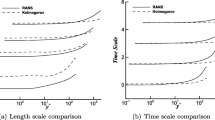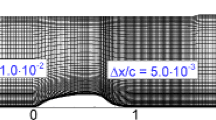Abstract
Delayed detached eddy simulation (DDES) has been proved to be suitable for the numerical simulation of massively separated flow. Whereas, there are still some drawbacks in the treatment of gray area, which is the transition zone between Reynolds-Averaged Navier–Stokes (RANS) and large eddy simulation (LES). In this paper, a modified DDES with shear layer adapted (SLA) subgrid length scale was employed, which takes advantage of the peculiarities of flow and grid topology in the initial shear layer, it can rapidly destabilize the separated shear layer and accelerate RANS to LES transition. To evaluate the performance of modified DDES versus conventional DDES, two typical separated flows are considered, they are the flow over backward-facing step with fixed geometry-induced separation and wall-mounted hump with non-fixed pressure-induced separation. The fifth-order Adaptive Dissipative Compact Scheme (ADCS) is also formulated to reduce numerical dissipation in grey area. The results show that the gray area can be slightly alleviated by ADCS, but it cannot be effectively mitigated with conventional DDES model. The visualizations of instantaneous flow reveal that the modified DDES is capable of unlocking the Kelvin–Helmholtz instability rapidly and accelerating the transition to resolved turbulence in the initial shear layer, which is strongly delayed by conventional DDES. The time-averaged pressure and skin friction coefficients show the mitigation of delayed transition as well. The distributions of mean velocity and Reynolds stress of modified DDES exhibit a rapid development in the initial shear layer; thus, more turbulent structures can be distinguished and the accuracy of results can be enhanced.



























Similar content being viewed by others
References
Lee HM, Kwon OJ (2019) Numerical simulation of horizontal axis wind turbines with vortex generators. Int J Aeronaut Space 20:325–334
Li Y, Zhang Y, Bai J (2020) Numerical simulation of the aerodynamic influence of aircrafts during aerial refueling with engine jet. Int J Aeronaut Space 21:15–24
Spalart PR, Jou WH, Strelets M, Steven A (1997) Comments on the feasibility of LES for winds, and on a hybrid RANS/LES approach. Adv DNS/LES 1:4–8
Spalart PR, Deck S, Shur ML, Squires KD, Strelets M, Travin A (2006) A new version of detached-eddy simulation, resistant to ambiguous grid densities. Theor Comp Fluid Dyn 20(3):181–195
Ekaterina K, Guseva A, Garbaruk V, Strelets M (2017) Assessment of delayed DES and improved delayed DES combined with a shear-layer-adapted subgrid length-scale in separated flows. Flow Turbul Combust 98(2):481–502
Spalart PR (2009) Detached-eddy simulation. Annu Rev Fluid Mech 41:181–202
Mockett C, Haase W (2018) The Go4hybrid project—motivation and objectives, project structure, test cases and project partners. In: Go4Hybrid: grey area mitigation for hybrid RANS-LES methods, notes on numerical fluid mechanics and multidisciplinary design, Springer International Publishing AG, vol 134, pp 3–13
Dhamankar ER, Blaisdell GA (2018) Overview of turbulent inflow boundary conditions for large eddy simulations. AIAA J 56(4):1317–1334
Mockett C, Fuchs M, Garbaruk A, Shur M, Spalart P, Strelets M, Thiele F, Travin A (2015) Two non-zonal approaches to accelerate RANS to LES transition of free shear layers in DES. In: Progress in hybrid RANS-LES modelling, notes on numerical fluid mechanics and multidisciplinary design, vol 130. Springer International Publishing, Switzerland, pp 187–201, 2015
Ducros F, Nicoud F (1999) Subgrid-scale stress modelling based on the square of the velocity gradient tensor. Flow Turbul Combust 62(3):183–200
Nicoud F, Toda HB, Cabrid O, Bose S, Lee J (2011) Using singular values to build a subgrid-scale model for large eddy simulations. Phys Fluids 23:085103
Fuchs M, Sesterhenn J, Thiele F, Mockett C (2015) Assessment of novel DES approach with enhanced SGS modelling for prediction of separated flow over a delta wing. In: 22nd AIAA computational fluid dynamics conference. Dallas, Texa, pp 2015–3433
Girimaji SS, Wallin S (2011) Commutation error mitigation in variable-resolution PANS closure: proof of concept in decaying isotropic turbulence. In: 6th AIAA theoretical fluid mechanics conference, Honolulu, Ha-waii, pp 2011–3105
Girimaji SS, Wallin S (2013) Closure modeling in bridging regions of variable-resolution (VR) turbulence computations. J Turbul 14(1):72–98
Girimaji SS, Wallin S (2014) Modelling energy scale transfer in variable resolution simulation of turbulence. Progress in hybrid RANS-LES modelling. Notes on numerical fluid mechanics and multidisciplinary design, vol 130. Springer, Cham, pp 19–21
Peng S-H (2005) Hybrid RANS-LES modeling based on zero- and one-equation models for turbulent flow simulation. In: Proceedings of 4th international symposium on turbulence and shear flow phenomena, vol 3. Williamsburg, Virginia, USA, pp 1159–1164
Peng S-H (2006) Algebraic hybrid RANS-LES modelling applied to incompressible and compressible turbulent flows. In: 36th AIAA fluid dynamics conference and exhibit, San Francisco, California, USA, 3910
Peng S-H, Davidson L (2002) Some remarks on approximation for subgrid scale modelling in large eddy simulation. Scientific Report, Swedish Defence Research Agency
Peng S-H, Davidson L (2009) Approximation of subgrid-scale stresses based on the Leonard expansion. In: 6th International symposium on heat and mass transfer, Rome, Italy
Peng S-H (2012) Hybrid RANS-LES modelling with an energy-backscatter function incorporated in the LES mode. In: Proceedings THMT-2012
Kok JC (2016) A stochastic backscatter model for grey-area mitigation in detached eddy simulations. Flow Turbul Combust 99:119
Chauvet N, Deck S, Jacquin L (2007) Zonal-detached-eddy simulation of a controlled propulsive jet. AIAA J 45(10):2458–2473
Deck S (2012) Recent improvement in the zonal detached eddy simulation (ZDES) formulation. Theor Comput Fluid Dyn 26:523–550
Shur ML, Spalart PR, Strelets M, Travin AK (2015) An enhanced version of DES with rapid transition from RANS to LES in separated flows. Flow Turbul Combust 95:709–737
Frohlich J, Von Terzi D (2008) Hybrid LES/RANS methods for the simulation of turbulent flows. Prog Aerosp Sci 44:349–377
Menter FR, Schutze J, Gritskevich M (2012) Global vs. zonal approaches in hybrid RANS-LES turbulence modelling. Notes on numerical fluid mechanics and multidisciplinary design, vol 117. Springer, Berlin, pp 15–28
Tucker P (2014) Unsteady computational fluid dynamics in aeronautics. Fluid mechanics and its application, vol 104. Springer, Cham
Peng S-H (2018) Free shear layer. In: Go4Hybrid: grey area mitigation for hybrid RANS-LES methods. Notes on numerical fluid mechanics and multidisciplinary design, vol 134. Springer International Publishing AG, pp 91–107
Deck S (2018) The spatially developing flat plate turbulent boundary layer. In: Go4Hybrid: grey area mitigation for hybrid RANS-LES methods. Notes on numerical fluid mechanics and multidisciplinary design, vol 134. Springer International Publishing AG, pp 109–121
Fuchs M, Mockett C, Shur M, Strelets M, Kok JC (2018) Single-stream round jet at \(\text{m} = 0.9\). In: Go4Hybrid: grey area mitigation for hybrid RANS-LES methods. Notes on numerical fluid mechanics and multidisciplinary design, vol 134. Springer International Publishing AG, pp 125–137
Fuchs M, Kok J, Mockett C (2018) Delta wing at high angle of attack. In: Go4Hybrid: grey area mitigation for hybrid RANS-LES methods. Notes on numerical fluid mechanics and multidisciplinary design, vol 134. Springer International Publishing AG, pp 139–153
Probst S, Probst A, Schwamborn D (2018) 3-Element airfoil. In: Go4Hybrid: grey area mitigation for hybrid RANS-LES methods. Notes on numerical fluid mechanics and multidisciplinary design, vol 134. Springer International Publishing AG, pp 155–171
Mockett C, Ashton N, Fuchs M, Duda B (2018) EC135 helicopter fuselage. In: Go4Hybrid: grey area mitigation for hybrid RANS-LES methods. Notes on numerical fluid mechanics and multidisciplinary design, vol 134. Springer International Publishing AG, pp 189–201
Sun G, Castiglioni G, Andrzej DJ (2019) On the estimation of artificial dissipation and dispersion errors in a generic partial differential equation. J Comput Phys
Bui TT (2000) A parallel, finite-volume algorithm for large-eddy simulation of turbulent flows. Comput Fluids 29(8):877–915
Qin N, Xia H (2008) Detached eddy simulation of a synthetic jet for flow control. J Syst Control Eng 222(5):373–380
Yoon S, Barnhardt M, Candler G (2010) Simulations of high-speed flow over an isolated roughness. In: 48th AIAA Aerospace sciences meeting including the new horizons forum and aerospace exposition. AIAA paper 2010-1573, January 2010
Klein M, Ciardi M, Saugaut P, Dawes WN (2005) A dynamic finite volume scheme for large-eddy simulation on unstructured grids. J Comput Phys 210(2):632–655
Travin A, Shur M, Strelets M, Spalart PR (2002) Physical and numerical upgrades in the detached-eddy simulation of complex turbulent flows. Adv Les Complex Flows 65:239–254
Mary I, Sagaut P (2002) Large eddy simulation of flow around an airfoil near stall. AIAA J 40(6):1139–1145
Tajallipour N, Owlarn BB, Paraschivoiu M (2009) Self-adaptive upwinding for large eddy simulation of turbulent flows on unstructured elements. J Aircr 46(3):915–926
Wang ZJ (2014) High-order computational fluid dynamics tools for aircraft design. Philos Trans R Soc Math Phys Eng Sci 372(2022):20130318
Nonomura T, Iizuka N, Fujii K (2010) Freestream and vortex preservation properties of high-order WENO and WCNS on curvilinear grids. Comput Fluids 39(2):197–214
Xiao Z, Jian L, Huang J, Song F (2012) Numerical dissipation effects on massive separation around tandem cylinders. AIAA J 50(5):1119–1136
Hiroshi M, Xiaogang D, Shen C (1996) A class of high-order dissipative compact schemes. In: AIAA, fluid dynamics conference. AIAA paper 96-1972, June 1996
Li H, Liu W, Wang S (2020) A method of adaptively adjusting dissipation for the simulation of separated flow. Acta Phys Sin Chin ed 69(14):154
Strelets M (2001) Detached eddy simulation of massively separated flows. In: AIAA Journal, pp 1–18
Tam CKW, Webb JC (1993) Dispersion–relation-preserving finite difference schemes for computational acoustics. J Comput Phys 107(2):262–281
Comte-Bellot G, Corrsin S (1971) Simple Eulerian time correlation of full and narrow-band velocity signals in grid-generated, “isotropic” turbulence. J Fluid Mech 48:273–337
Driver DM, Seegmiller HL, Marvin JG (1987) Features of reattaching turbulent shear layer in divergent channel flow. AIAA J 23(2):163–171
Rumsey C (2020) Langley resource centre turbulence modeling resource. http://turbmodels.larc.nasa.gov/
Strelets M, Schwamborn D (2012) ATAAC—an EU-project dedicated to hybrid RANS/LES methods. In: Progress in hybrid RANS-LES modelling. Notes on numerical fluid mechanics and multidisciplinary design, vol 117. Springer, Berlin, pp 59–75
Paschal KB, Yao C-S, Harris J, Schaeffler NW, Washburn AE, Greenblatt D (2005) A separation control CFD validation test case part 2—zero efflux oscillatory blowing. In: 43rd AIAA aerospace sciences meeting and exhibit, 2005–0485
Acknowledgements
This work is supported by the National Key Project(No.GJXM92579), Natural Science Foundation of Hunan Province, China(No.2020JJ5648) and Scientific Research Project of NUDT(NO. ZK20-43).
Author information
Authors and Affiliations
Corresponding author
Additional information
Publisher's Note
Springer Nature remains neutral with regard to jurisdictional claims in published maps and institutional affiliations.
Rights and permissions
About this article
Cite this article
Hao, L., Wei, L. & Shengye, W. Numerical Investigation of Fixed and Non-fixed Separation with Shear Layer Adapted Delayed Detached Eddy Simulation. Int. J. Aeronaut. Space Sci. 22, 531–546 (2021). https://doi.org/10.1007/s42405-020-00342-y
Received:
Revised:
Accepted:
Published:
Issue Date:
DOI: https://doi.org/10.1007/s42405-020-00342-y




